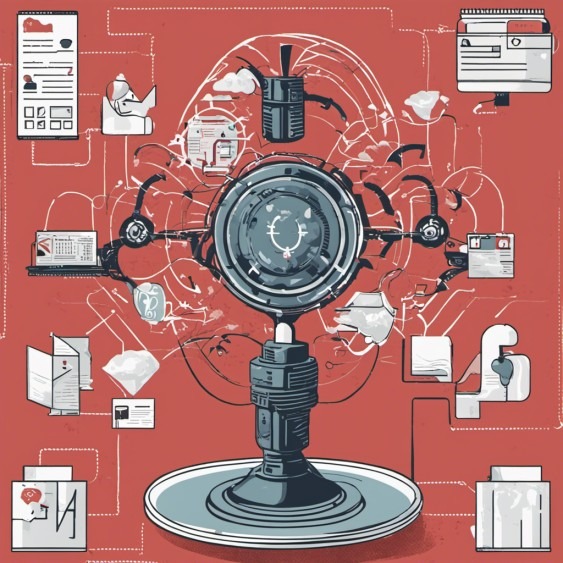
What is Data Manipulation: Its Nefarious Uses
Feb 5, 2024
Data manipulation is a practice that involves distorting and altering data to deceive and mislead. In our digital age, where data plays a crucial role in shaping our understanding of the world, it is essential to be aware of the nefarious uses of data manipulation and its potential consequences.
**Data manipulation** refers to various techniques bad actors employ to manipulate information for their gain. This can include selectively choosing data points that support a particular viewpoint while disregarding contradictory evidence, fabricating statistics, and altering graphs to create false trends. The aim is to shape narratives and deceive individuals who rely on data for decision-making.
One area where data manipulation is prevalent is in politics. Politicians often spin facts and figures to bolster their agendas or discredit opponents. By carefully selecting and presenting data, they can manipulate public opinion and shape the narrative in their favour. Similarly, in finance and economics, data can be misconstrued to push specific monetary perspectives, potentially influencing investment decisions and market behaviour.
Even in scientific and medical research, the pressure to publish and secure funding can incentivize researchers to manipulate data to achieve desired outcomes. This can undermine the integrity of scientific findings and hinder progress in various fields.
The consequences of data manipulation are far-reaching. It erodes trust in institutions, fuels misinformation, and undermines evidence-based decision-making. When data is manipulated, making informed choices and accurately assessing the state of affairs becomes challenging.
To combat data manipulation, we must equip ourselves with the knowledge and tools to identify and challenge such practices. By understanding the techniques used and the potential impacts, we can become more discerning data consumers and safeguard the integrity of information in our increasingly interconnected world.
Real-World Examples and Tactics
We will delve into real-world examples to illuminate the tactics employed by those aiming to distort information through data manipulation. Following this, we will expand on several of these topics.
1. **Cherry-picking data**: Bad actors selectively choose data points that support their desired narrative while ignoring contradictory evidence. This can create a skewed perception of reality and mislead individuals who rely on the presented data.
2. **Fabricating statistics**: Manipulators may fabricate statistics to create false trends or exaggerate the significance of certain phenomena. By presenting manipulated statistics, they can influence public opinion and decision-making processes.
3. **Altering graphs**: Graphs are powerful visual tools that can be manipulated to misrepresent data. Manipulators may alter graphs’ scale, axes, or labels to create a distorted perception of trends or relationships.
4. **Spinning narratives**: Manipulators craft narratives around data to shape public opinion. By carefully selecting and presenting data in a biased manner, they can influence the interpretation of events and steer the conversation in their desired direction.
Cherry-Picking Data
Cherry-picking data is a deceptive tactic used to manipulate information by selectively choosing data points that support a particular viewpoint while disregarding contradictory data. This method can create a skewed representation of reality and mislead others into accepting a false narrative.
For instance, imagine a study on the effectiveness of a new medication. The researchers selectively highlight positive outcomes and favourable statistics while downplaying or omitting any adverse results. By cherry-picking the data, they imagine the medication is highly effective, even if the evidence suggests otherwise.
In politics, cherry-picking data is often employed to support specific policy agendas. Politicians may selectively cite statistics that bolster their arguments while ignoring data that contradicts their claims. For example, a politician advocating for stricter immigration policies might focus on isolated incidents of crimes committed by immigrants while disregarding the broader data that shows immigrants have lower crime rates compared to native-born citizens.
Cherry-picking data can also be seen in media reporting. News outlets may selectively present data that aligns with their editorial bias, leading to a distorted representation of events. This can perpetuate misinformation and shape public opinion based on incomplete or misleading information.
Awareness of cherry-picking tactics and critical evaluation of the data presented is essential. By considering the full range of information and seeking diverse perspectives, we can avoid falling victim to manipulated narratives and make more informed decisions.
Remember, comprehensive and unbiased data analysis requires examining the complete picture, including supporting and contradictory evidence.
False Correlations
False correlations occur when two unrelated data points are erroneously linked, creating the illusion of a causal relationship. This misleading technique is often used to manipulate information and promote a specific agenda. One example of a false correlation is the association between increasing autism rates and the growth in organic food sales.
In this scenario, a fake news graphic may depict a rising trend in autism rates alongside the increasing popularity of organic food. However, it is important to note that this correlation does not imply a cause-and-effect relationship between organic food consumption and autism. Both factors may be increasing independently due to other unrelated factors.
False correlations can be misleading and can lead to misguided conclusions. They exploit the human tendency to seek patterns and connections, even when they do not exist. Evaluating the evidence critically and considering alternative explanations before accepting a correlation as evidence of causation is crucial.
Another example of a false correlation is the infamous “ice cream and crime” correlation. It has been falsely claimed that there is a direct relationship between ice cream sales and crime rates, suggesting that more ice cream sales lead to increased crime. However, the correlation is spurious, as both ice cream sales and crime rates tend to increase during the summer months due to external factors such as warmer weather.
Fabricating Statistics
Fabricating statistics involves the deliberate creation or alteration of data to support a particular narrative or agenda. This deceptive practice can take various forms, including completely making up numbers, doctoring graphs to exhibit fabricated trends, or digitally editing photos and videos to present false information.
One example of fabricated statistics is the manipulation of opinion polls during political campaigns. Poll results can be distorted by selectively choosing respondents or manipulating the wording of questions to elicit desired responses. By fabricating statistics, political actors can create the illusion of widespread support for their policies or candidates, influencing public opinion and swaying election outcomes.
In marketing, companies may fabricate statistics to promote their products or services. They might claim exaggerated success rates, inflated customer satisfaction ratings, or misleading competitor comparisons. These companies aim to deceive consumers and gain a competitive advantage by presenting fabricated statistics.
Fabricated statistics can also be found in scientific research. While outright fraud is rare, researchers may be tempted to manipulate data to achieve desired outcomes or secure funding. This can involve selectively omitting data points that do not align with the desired results or altering statistical analyses to produce more favourable findings. Such practices undermine the integrity of scientific research and can have severe consequences for public health and policy decisions.
It is crucial to be vigilant and critically evaluate the sources and methodologies behind statistical data. By questioning the validity and reliability of statistics, we can guard against the spread of disinformation and make more informed decisions based on accurate information.
Data Manipulation in Finance and Economics
The finance and economics spheres are prime targets for data manipulation to push specific monetary agendas or perspectives. Statistics related to economic growth, unemployment, inflation, and other fiscal factors can be misconstrued.
For example, the Labor Department’s monthly jobs report is a crucial indicator of US economic health. The unemployment rate is highly influential, impacting fiscal policy and swaying public opinion. However, this percentage can be misleading. The widely reported unemployment rate only accounts for people actively looking for jobs, not those who have given up searching. So, the true joblessness rate is likely higher.
The Consumer Price Index (CPI), which measures inflation, is another statistic that can be manipulated. The methodology for calculating CPI has changed over time, including switches to geometric weighting and substitutions for certain goods. These changes have resulted in lower CPI values, helping the government downplay the true inflation rate.
Financial markets also present opportunities for data manipulation. Companies may exploit grey areas in accounting rules to misrepresent earnings, assets, or other figures to appear more profitable. Insider trading based on non-public data also engenders an unfair advantage.
Politicians and advocates often misuse economic data and statistics to boost their agendas or discredit opponents. A common tactic is citing biased or flawed polls and surveys that support their position. Leading questions and limited sampling are ways to produce favoured results. Polls can also be selectively filtered to highlight agreeable responses and downplay dissenting opinions. This allows politicians to claim public support for their policy agendas, even if that support is exaggerated.
Demographic data can also be manipulated in politics through practices like gerrymandering. Electoral district maps are redrawn to dilute the voting power of certain groups and bolster that of others. Both major US parties have been accused of gerrymandering, which skews representation.
Misusing and misrepresenting data allows political agendas to gain traction. But it also fosters distrust and polarization when the public perceives statistics as malleable to fit any narrative. Transparency in data collection and methodology is essential to maintaining integrity.
Data Manipulation in Science and Medicine
The legitimacy of scientific research rests on accurate data. However, the pressure to publish and obtain funding can incentivize less-than-ethical data practices. While outright fraud is rare, more subtle manipulation does occur in science.
Cherry-picking favorable results and omitting negative ones is one-way researchers introduce bias. Running multiple variants of an experiment but only publicizing positive outcomes can lend undue credence. And statistical significance is sometimes misrepresented through practices like p-hacking.
Researchers may manipulate how data is analyzed to achieve more significant p-values that imply stronger evidence. However, low p-values can arise by chance through multiple iterations. So, such findings may be statistical artefacts rather than real effects.
Some researchers also craft hypotheses to fit pre-existing data sets. This process generates ideas that have not been properly tested and validated. And studies can be designed in ways that support expected outcomes, undermining objectivity.
In medicine, pharmaceutical companies fund extensive drug research, creating potential conflicts of interest for scientists. Company-sponsored studies are more likely to report favourable drug efficacy and safety outcomes. Trials with unfavourable results often go unpublished.
Doctors can also be improperly induced to prescribe certain drugs. Pharma reps exaggerate benefits and downplay risks. And paid speaking engagements, gifts, and other incentives sway physicians to favour certain medications.
Such data manipulation in science and medicine damages public trust. It also leads to ineffective or even harmful treatments as interventions’ authentic safety and efficacy become obscured. Upholding rigorous research standards is essential.
Data Manipulation in Journalism and Social Media
Media outlets and social networks have enabled the rapid spread of disinformation. Lax oversight on verifying sources and facts has allowed data manipulation to increase.
News organizations often source statistics with inherent biases from special interest groups or think tanks. But they may present the figures as impartial without proper vetting. Or they may extrapolate insupportable conclusions that overstate research findings.
Also, stories focusing on outliers or rare events can stoke disproportionate fears. For instance, a few violent crimes by immigrants may be publicized to imply high crime rates overall among immigrants. In reality, immigrants have lower criminality than native-born citizens. But such stories can manipulate public sentiment.
On social media, fabricated images and videos distort reality. Doctored photos and deepfakes falsely depict events that never happened or present a distorted narrative. Meanwhile, bots and fake accounts are used to spread false data, making it seem more widely believed than it is.
A significant source of data manipulation is hyperpartisan websites that masquerade as legitimate news. They publish inflammatory, false stories to serve particular agendas. And readers who agree with those viewpoints accept the fake stories as accurate without scrutiny.
Media literacy and fact-checking are crucial to combating such data manipulation. Evaluating sources, seeking consensus from reputable outlets, and consulting primary sources can verify the information. Quality journalism is needed to cut through the disinformation.
Data Manipulation Fuels Misinformation
In summary, data manipulation is a driving force behind the proliferation of fake news and disinformation. Inaccurate or misleading statistics and information are intentionally used to shape false narratives. These false narratives then influence public opinion and policies.
To combat disinformation, individuals must approach data with critical thinking. Evaluate where statistics come from, how they were collected, and how they are presented. Be wary of cherry-picked, biased, or outright fabricated numbers. Also, be aware of correlation versus causation. And look for scientific consensus rather than single outliers.
Transparent, valid data is the antidote to misinformation. Scientists, researchers, journalists, and politicians must represent data truthfully. And the public must scrutinize the information they are presented with before accepting it as fact.
Society cannot afford to make decisions based on faulty data. Misguided policies, markets, behaviours, and beliefs can arise. Its integrity can be maintained only by upholding rigorous standards in gathering, analyzing, reporting, and peer-reviewing data. In the information age, dedication to facts and objective truth is imperative.
Conclusion
In this era of unprecedented access to information, the battle against data manipulation is not just a matter of intellectual curiosity but a fundamental quest for truth and integrity. As we’ve journeyed through the intricacies of data manipulation and its nefarious uses, we’ve witnessed how data, a powerful tool in its purest form, can be twisted and contorted to serve ulterior motives.
Data manipulation is the dark underbelly of our information age. It thrives on cherry-picked facts, false correlations, fabricated statistics, and the deliberate misinterpretation of data. It knows no boundaries, infiltrating politics, economics, science, medicine, journalism, and social media. Its corrosive influence erodes public trust, distorts perceptions, and drives decisions that can have far-reaching consequences.
But our journey has also revealed a ray of hope: the power of critical thinking and transparency. As individuals, we can arm ourselves with scepticism, asking probing questions about the sources and methods behind the data we encounter. We can seek consensus among reputable sources and shun the seductive allure of sensationalist narratives. Education and media literacy are our allies in this fight, helping us navigate the treacherous waters of misinformation.
Moreover, the responsibility extends beyond individuals. Scientists, researchers, journalists, and politicians must uphold the sanctity of data, presenting it faithfully and transparently. Society cannot afford to make decisions based on faulty data. Misguided policies, misallocated resources, and public discord are among the dire consequences of data manipulation.
In conclusion, data integrity is not a luxury; it’s a necessity. It’s a moral imperative that transcends political, cultural, and societal boundaries. To emerge victorious in this battle against data manipulation, we must champion the principles of accuracy, transparency, and critical thinking. Only then can we navigate the complex web of information and emerge with a clearer understanding of the world, grounded in facts and driven by objective truth.
Intriguing Articles for Knowledge Seekers
Market Update Tactical Investor Past Calls: The Trend Is Your Friend
Dow Jones Industrial Average Stocks Soar Slaughtering the Bears
Gold buying Spree Russia & Russian Strength?

China’s corruption crackdown targets both big & small officials
China Corruption: Fast & Furious crackdown
The Big Picture: Lower oil & energy prices
Crude oil price projections: will oil prices stabilize
The Middle Class Squeeze: 4.00 in 1973 equates to 22.41 today
Syria War News: It Is All About Blood, Guns & Money
For Many Americans Great Recession Never Ended
Is VIX pointing to a stock market crash in 2016?
Belt & Road Initiative: Taking China’s culture beyond borders
EU stands to benefit by Granting China free market status
China cuts rates to boost green energy demand

China showcases its culture to the World
Stock Market Correction History: Decoding Illusions Behind Crashes


